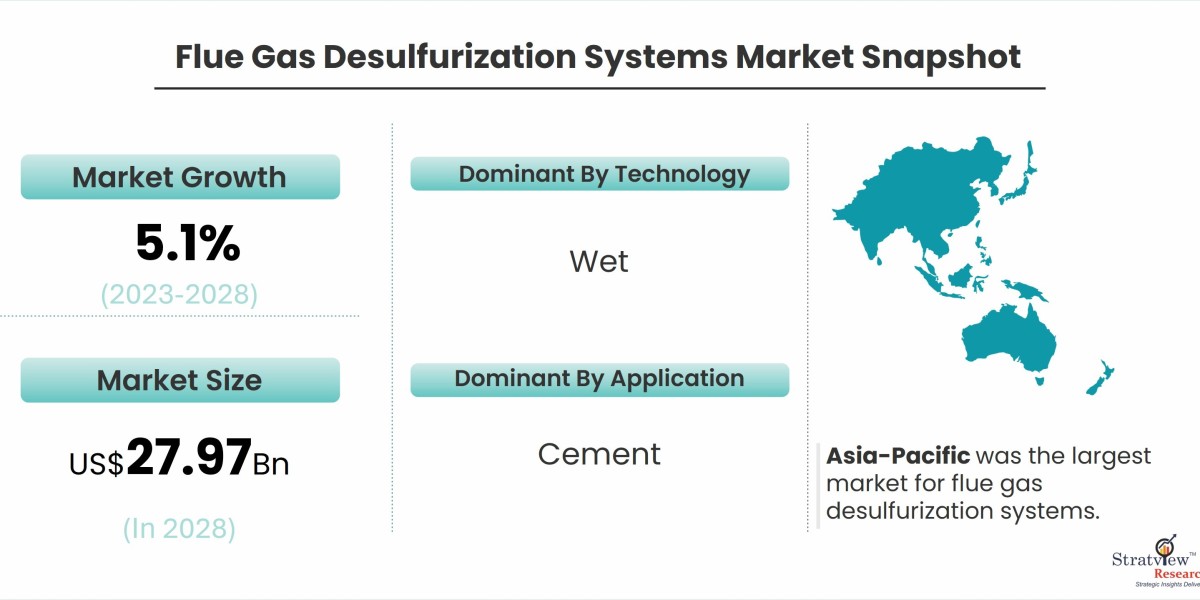According to Stratview Research, the flue gas desulfurization systems market was estimated at USD 20.7 billion in 2022 and is likely to grow at a CAGR of 5.1% during 2023-2028 to reach USD 27.97 billion in 2028.
In the ongoing battle against air pollution and its adverse environmental impacts, the Flue Gas Desulfurization (FGD) Systems Market emerges as a key player in clearing the air we breathe. As industries grapple with the challenges of reducing sulfur dioxide emissions, FGD systems have become integral to the pursuit of cleaner and more sustainable operations. This article takes a comprehensive journey into the Flue Gas Desulfurization Systems Market, shedding light on its significance, evolving technologies, and the role it plays in ushering a new era of environmental responsibility.
The Need for Clean Air: Air pollution, driven primarily by industrial activities, poses significant threats to both human health and the environment. Sulfur dioxide (SO2) emissions, a byproduct of burning fossil fuels, contribute to acid rain, respiratory issues, and ecological damage. Recognizing the imperative need for clean air, industries are increasingly turning to Flue Gas Desulfurization Systems as a vital component in their environmental stewardship.
Understanding Flue Gas Desulfurization Systems: Flue Gas Desulfurization Systems, commonly known as FGD systems, are a set of technologies designed to remove sulfur dioxide from flue gases produced during combustion processes in power plants and industrial facilities. The core objective is to mitigate the environmental impact of sulfur emissions by converting sulfur dioxide into environmentally benign byproducts.
Key Components of FGD Systems:
Absorbers: The heart of FGD systems, absorbers utilize various chemical processes to capture sulfur dioxide from flue gases. Commonly used absorbents include limestone and lime slurry.
Spray Towers and Scrubbers: These components facilitate the contact between flue gases and the absorbent, ensuring effective sulfur dioxide removal.
Reaction Tanks: Where the chemical reactions take place, converting sulfur dioxide into less harmful compounds like calcium sulfate or gypsum.
Dewatering Systems: Responsible for separating the absorbed sulfur compounds from the liquid, producing a waste stream that can be safely disposed of.
Benefits of FGD Systems:
Air Quality Improvement: By removing sulfur dioxide, FGD systems contribute significantly to reducing air pollution, improving ambient air quality, and mitigating the impact on respiratory health.
Environmental Protection: FGD systems play a crucial role in preventing acid rain, a phenomenon caused by sulfur dioxide emissions that can harm ecosystems, water bodies, and soil.
Regulatory Compliance: Many countries enforce strict emissions standards, and FGD systems are instrumental in helping industries comply with environmental regulations, avoiding penalties and ensuring sustainable operations.
Community Health Enhancement: The implementation of FGD systems positively impacts nearby communities, reducing their exposure to harmful pollutants and fostering a healthier living environment.
Technological Advancements in FGD Systems: As industries strive for increased efficiency and environmental sustainability, the Flue Gas Desulfurization Systems Market has witnessed technological advancements. Innovations include:
Dry FGD Systems: These systems use dry sorbents, eliminating the need for liquid waste disposal and providing flexibility in plant design.
Advanced Scrubber Designs: Enhanced scrubber technologies and optimized designs contribute to improved absorption efficiency, reducing overall operational costs.
Integration with Renewable Energy: Some FGD systems are being integrated with renewable energy sources, showcasing a holistic approach to sustainability within industrial operations.
Challenges and Future Outlook: While FGD systems have proven effective in reducing sulfur dioxide emissions, challenges such as high installation costs, energy consumption, and the management of waste byproducts persist. The industry is actively addressing these challenges through ongoing research, development, and the exploration of alternative absorbents and technologies. The future outlook of the Flue Gas Desulfurization Systems Market is optimistic, with a growing emphasis on sustainable solutions that balance environmental responsibility with economic feasibility.
Global Impact and Market Growth: The Flue Gas Desulfurization Systems Market has witnessed substantial growth, driven by the global commitment to environmental conservation. Increasing awareness of the detrimental effects of sulfur dioxide emissions, coupled with stringent emissions standards, has propelled the market forward. Regions with high industrial activities, such as Asia-Pacific and North America, are experiencing significant market expansion.
Conclusion: As the world grapples with the urgent need to address air pollution and its environmental consequences, the Flue Gas Desulfurization Systems Market stands as a beacon of hope. Clearing the air from sulfur dioxide emissions, these systems play a pivotal role in promoting sustainable industrial practices, protecting human health, and preserving the delicate balance of our ecosystems. With ongoing innovations and a growing global commitment to environmental stewardship, the Flue Gas Desulfurization Systems Market is set to continue its crucial role in creating a cleaner, healthier future for generations to come.







